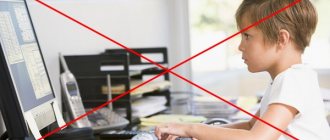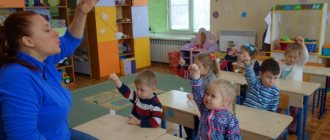Article “Means and methods of working with blind children in the context of the implementation of the Federal State Educational Standard”
Means and methods of working with blind children in the context of the implementation of the Federal State Educational Standard
In the context of the implementation of the Federal State Educational Standard for Education, we are talking, first of all, about the need to create equal conditions and opportunities for the training and education of children with disabilities.
Every year we see an increasing trend in the number of children with complex developmental disorders. The senior group of our kindergarten is attended by 4 visually impaired children (blind and visually impaired children with complex developmental disorders). Each of them requires special attention, means, techniques and methods of teaching. Today I would like to share my work experience.
The preschool educational institution has developed an adapted basic educational program, which presents the clinical, psychological and pedagogical characteristics of all categories of children and defines the content component. The program was developed in accordance with the Federal State Educational Standard for Education, taking into account the approximate basic educational program “From birth to school” and the author’s partial program for children with visual impairments, ed. L.I. Plaksina. At the same time, special individual development programs (SIDP) are being developed for children with complex developmental disorders.
The specifics of the adapted basic educational program of the preschool educational institution are:
— correctional focus;
— continuity of the main correctional and educational process;
— protection and promotion of the health of pupils;
— correction of visual functions;
- preservation and maintenance of individuality;
- social adaptation.
All kindergarten specialists implement a comprehensive, clinical, psychological and pedagogical approach to diagnosis and correctional assistance for children with disabilities.
In the work of teachers, individual and differentiated approaches are observed, including various forms and methods of working with children with disabilities.
Blind and visually impaired children, along with all children, take an active part in all types of children's activities: cognitive, gaming, physical education, artistic and aesthetic, and others.
Teaching blind and visually impaired preschoolers spatial orientation includes:
- formation of the need for independent orientation and movement;
-overcoming fear of space and self-doubt;
- mastering the skills of orientation in the diagram of one’s own body;
- training in methods and techniques of orientation in microspace (at a table, on a sheet of paper).
As has already been said by previous speakers, a blind child attends all correctional and general education classes. In connection with this, they require special attention during classes. Thus, during examination of objects or explanation of instructions, much more time is required. According to the model of training and education of blind children in our preschool educational institution, narrow specialists in the person of a teacher-defectologist, a teacher-speech therapist, an educational psychologist replace each other and accompany children with complex developmental disorders in the classroom, select and adapt, taking into account the capabilities of the children, a variety of stimulus and didactic materials.
It is important in the formation of compensatory skills to include intact analyzers in all types of activity (touch, smell, hearing, proprioceptive sensitivity - muscle sense, sensation of the position of parts of one’s own body relative to each other and in space).
The sense of touch is of exceptional importance for a blind and visually impaired preschooler, since it is the main way of cognition, object and spatial orientation. Tactile sensibility allows you to qualitatively examine an object, study its spatial and physical properties. When examining objects, the teacher controls the child’s actions by placing his hands on the child’s hands or acting “hand in hand”, standing behind the child’s back.
Examination techniques:
1st technique – hands are on opposite sides of the object and simultaneously move from top to bottom. With this movement of the hands, a feeling of the shape and size of the object and some of its other properties immediately appears.
2nd technique - one hand remains motionless, and the other slides from top to bottom on the opposite side of the object, then vice versa.
Initially, children are very selective in the perception of objects of different textures; they are often frightened by new sensations. At such a moment, it is necessary to interest the child or switch attention to another type of activity (so as not to form a negative attitude or discourage desire).
At the same time, in physical education and health classes, as part of correctional work with children, we develop the ability to use the soles of our feet to evaluate, identify, recognize coatings, the quality of the floor surface: rugs (ribbed, prickly, soft, rough), obstacles, holes, bumps . Such exercises help develop the perception of space.
There are many different sounds and noises in the environment around us, so one of the main tasks of correctional and compensatory work is the development of auditory perception of the surrounding space. When working with children, attention is paid to listening to the voices of birds, animals, sounds of transport... At the same time, children are asked to compare how the sound of an object changes on the same surface depending on what material it is made of (iron, wood, fabric, etc.) .d.).
Visual impairment negatively affects overall physical development and health. Children with ND have reduced motor activity and overall functional health.
Physical education is carried out in the form of morning exercises, classes, sports and outdoor games.
On the slide you can see how a physical education instructor in his work uses various corrective techniques and methods, sets of exercises aimed at developing muscle tone and motor activity. During physical education classes there is musical accompaniment, which sets an additional rhythmic design and thereby makes it easier for the child to perform the exercises well. The exercises are initially performed by the child together with the teacher, and after the development of the necessary skills, the child performs the exercises independently.
Experience in working in a kindergarten for children with visual impairments has led to the conclusion that music classes are entertaining, help relieve motor stiffness, and evoke the greatest emotional response in children, interest and joy.
Musical and rhythmic exercises, games, round dances and dances allow a child with visual impairments to overcome difficulties in spatial orientation, lack of coordination of motor acts, their arrhythmia and physical inactivity.
Teachers of the institution, with the active participation of parents of students, create various didactic games and manuals that contribute to the organization of correctional and educational activities. The manuals are varied and aimed at developing fine motor skills and touch, developing plane orientation skills, and developing object concepts.
I would also like to determine the important role of the Lego constructor when working with children with visual impairments.
The use of LEGO constructors in the educational process when working with children with complex developmental disorders has a positive effect on:
development of fine motor skills, facilitated by small parts;
development of thinking (analysis, synthesis);
development of mathematical concepts
development of spatial orientation;
development of subject concepts using three-dimensional LEGO models of the surrounding subject world;
preparing the child’s hand for reading and writing using the L. Braille system.
On slide
When preparing to teach literacy to blind and visually impaired preschool children, it is necessary to use aids that facilitate the assimilation of the Louis Braille dot system. At the same time, benefits should help this process, and not slow it down. Training takes place in the game. During activities, it is necessary that work with benefits is always carried out with both hands.
So, when introducing a blind, visually impaired child to six dots, we use 2x3 LEGO bricks in our work. This brick is very similar to the Braille six-dot device.
The child, according to the teacher’s verbal instructions, places 1x1 bricks on the surface of a 2x3 brick. After which he can repeat the layout on a similar brick. Or come up with a layout yourself and copy it.
This method of copying a layout will later serve as an introduction to such a device as a Braille line.
Also, thanks to the constructor, you can easily build models, labyrinths and much more, which will increase the student’s interest and contribute to the child’s development.
Drawing, modeling, applique are the main types of visual activities through which children figuratively reflect the surrounding reality. Visual activity is important for the comprehensive development and perception of children with visual impairments and serves as an important means of correcting compensation for visual impairment.
Throughout the training, there is clarification, specification, generalization of subject concepts, and the formation of examination methods. When developing visual skills, tasks should be organized individually, taking into account the child’s capabilities, his vision and general development.
In order to give children a full opportunity to demonstrate their artistic capabilities, we come up with various methods and techniques of drawing, such as: painting with puffy paints, drawing on foil, painting using the chipping method, plasticine painting and more.
I would like to express my deep gratitude to the manager, colleagues, specialists, teachers, assistant teachers, parents, because cohesion, close cooperation and interaction, the common goal that each of us pursues, allows our students to feel successful, independent and competitive.
I would like to conclude my speech with the following words: “We don’t teach them - we create the conditions in which they learn” (Seymourt Papert).







